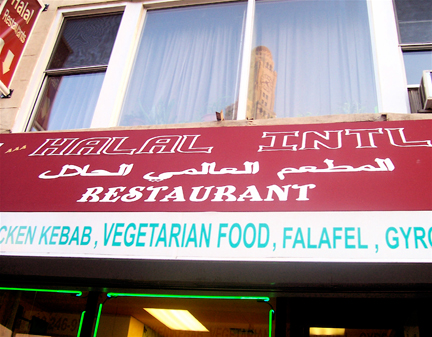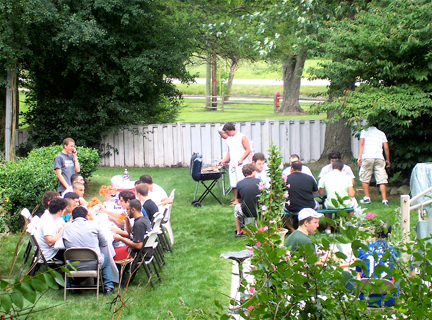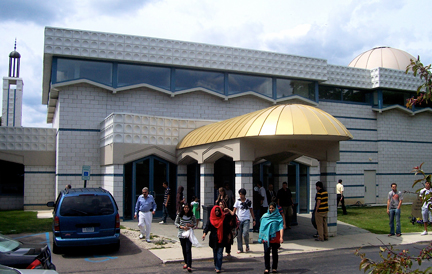
Arab restaurant in Brooklyn, NY; photograph by El-Sayyid el-Aswad
by El-Sayed el-Aswad, United Arab Emirates University
The concept of travel or movement implies the spreading of cultural elements beyond the confinements of locality. Being positioned on the boundary, signifying the division between home and away, inspired Arab Americans to identify themselves with both Arab and non-Arab or Western and non-Western cultural elements. Put differently, Arab Americans have experienced a gradually emerging sense of unified identity, or a reconfiguration of Arab identities, framed by the American culture as well as by the deep consciousness of, and identification with, the heritage of their old homelands, encompassing, for example, Arabic language, traditions or social customs, religious values, art and music. This is especially so since the events of 9/11. Arab Americans have been viewed by many non-Arab Americans as being terrorists or in sympathy with terrorism. They have made open attempts to offer clarification about their heritage and to teach others about their religion (especially Islam) in an attempt to dissuade reluctances, intolerances, and injustices against them.
The polarities of West and East, West and Islam, North and South, Christian and Muslim, Sunni and Shi‘a, home and away among others are reconstituted, blended and transformed, through narrating travel and movement experiences, into flexible and plastic components of the new identity of Arab American. By and large, peoples of South/East societies, especially those oppressed by Western imperialism, have turned up in North/West societies. Peoples, communication, information, and material goods traverse cultural and national borders, creating all kinds of transnational and hybrid identities that change and reconstruct themselves in unpredictable ways.

Young Arab Americans barbecuing in Michigan; photograph by El-Sayyid el-Aswad
A new ‘Arab American’ identity was also expressed by a successful Arab immigrant, who said, “I’m witnessing positive changes in my life, economically, socially, culturally and politically. I’m having a new identity that brings new light and strength to me. It is a unique blend of both the traditional and ‘new’ modern sides of ‘me’. It is a combination of sameness and difference. It is like speaking two or several languages by the same person.â€
People from different Arab or home countries (such as Egypt, Jordan, Iraq, Lebanon, Palestine, Syria, Yemen and so like) may come together at the local mosque to pray for and lament the loss of young Arab Americans whose lives were lost as they visited their home countries and/or were killed in the war.
Looking more closely at the Arab American identity from the inside, one finds that there are multiple or “half and half†identities associated with particular Arab homelands such as Egypt, Iraq, Jordan, Lebanon, Palestine, Syria, Yemen, among others. While there is a grand unity in one sense, there is more opportunity for “segregated communities” within the Arab-American community in the US to exist.

Islamic center in Bloomfield Hills, Michigan; photograph by El-Sayyid el-Aswad
In Dearborn, Michigan, for example, I never heard the interviewees with reference to themselves, saying such phrases as “half Arab and half Americanâ€, but rather they used phrases such as “half Egyptian and half Americanâ€, “half Syrian and half American†and “half Lebanese and half Americanâ€. While phrases such as “half Egyptian and half American†and/or “half Syrian and half American†signify diversity and multiplicity, the phrase “Arab American†connotes unity, notwithstanding the implicit multiplicity.
For more information see, el-Aswad, el-Sayed. 2010. “Narrating the Self among Arab Americans: A Bridging Discourse Between Arab tradition and American Culture,†Digest of Middle East Studies (DOMES) in 19(2):234-248, 2010.